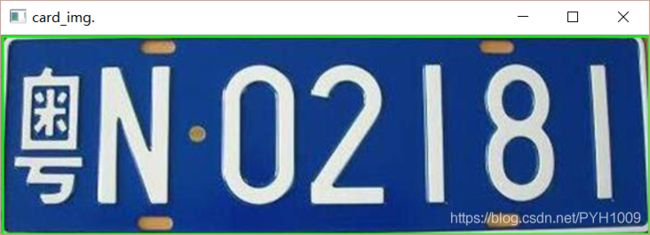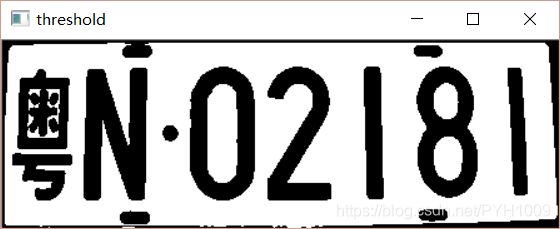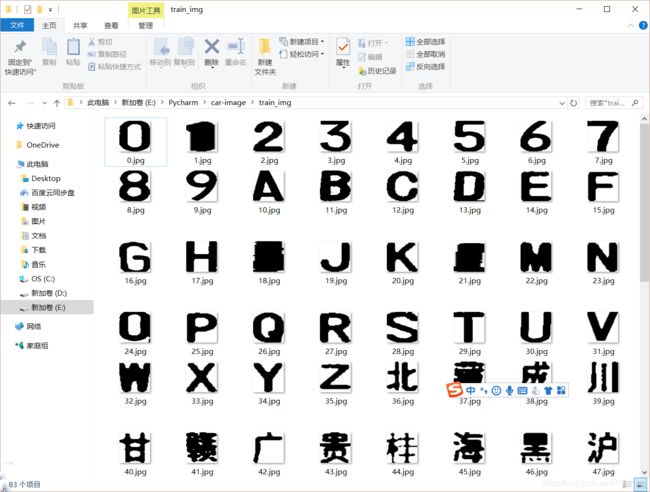基于Python的车牌识别(切割及识别)
基于Python的车牌识别(切割及识别)
上一篇博文简单的分享车牌定位,这次,将定位出来的车牌进行分割并识别出该字符。
1、车牌定位及提取
2、车牌二值化
def split_char(image):
# 改变车牌号大小
image = cv2.resize(image, (445, 150))
# 高斯模糊
blurerd = cv2.GaussianBlur(image, (3, 3), 0, 0, cv2.BORDER_DEFAULT)
# 图像转灰度
gray = cv2.cvtColor(blurerd, cv2.COLOR_BGR2GRAY)
kernel = np.ones((3, 3), np.uint8)
# kernel = cv2.getStructuringElement(cv2.MORPH_RECT, (5, 5))
# img_opening = cv2.morphologyEx(gray,cv2.MORPH_CLOSE,kernel)
# img_opening = cv2.addWeighted(gray,1,img_opening,-1,0) #将两张图片相融合
# 将灰度图像转换为二值化,设定阈值是100 (黑白照片)
w=12 #分割图片的最小值
A = 80
P = 0.98
while A<101:
ret, img_thre = cv2.threshold(gray, A, 255, cv2.THRESH_BINARY_INV)
# img_thre = cv2.erode(img_thre, kernel)
cv2.imshow("threshold", img_thre)
# cv2.imwrite(output_dir + '/' + 'img_thre' + '.jpg', img_thre)
# cv2.waitKey(0)
3、分割
(1)分割主要采用的方法是投影,通过设置阈值将图片先水平分割(去掉上下水平线)
# 分割图像
white = [] # 记录每一列的白色像素总和
black = [] # 记录每一列的黑色像素的总和
height = img_thre.shape[0]
width = img_thre.shape[1]
white_max = 0
black_max = 0
# 计算每一行的黑白像素的总和
for i in range(height):
s = 0 # 这一行白色总数
t = 0 # 这一行黑色总数
for j in range(width):
if img_thre[i][j] == 255:
s = s + 1
if img_thre[i][j] == 0:
t = t + 1
white_max = max(white_max, s)
black_max = max(black_max, t)
white.append(s)
black.append(t)
# print("第%d行:white[%d]=%d,black[%d]=%d" % (i, i, s, i, t))
arg = True # False表示白底黑字,True表示黑底白字
if black_max > white_max:
arg = False
# print("width:%d,height:%d" % (width, height), arg)
# print("whitemax:%d blackmax:%d" %(white_max,black_max))
f = 0.8
# 去除上下水平线
def find_end(start_):
end_ = start_ + 1
for m in range(start_ + 1, height - 1):
# 0.95参数可多调整,对应下面的0.05
if (black[m] if arg else white[m]) > (0.95 * black_max if arg else f * white_max):
# print(white[m],0.94 * white_max)
end_ = m
break
return end_
n = 1
start = 1
img_thre2 = None
J=0
for i in range(200):
if n < height - 2:
n = n + 1
while n < height - 2 and black[n] == width:
n = n + 1
if (white[n] if arg else black[n]) > (0.05 * white_max if arg else 0.22 * black_max):
# 以上是判断白底黑字还是黑字白底
# 0.05可调整,对应上面的0.95
start = n
end = find_end(start)
n = end
img_thr2 = False
#print(start, "-", end)
if end - start >= 90:
#print(start, "-(有效)", end)
img_thre = img_thre[start:end, 1:width]
cv2.imshow("cai", img_thre)
img_thr2 = True
elif((img_thr2==False) and (f!=1.0)):
f = f+ 0.01
#print(f)
n = n-1
else:
break
else:
break
(2)进行垂直分割后的图片分割成七个字符图片
# 垂直分割
white = [] # 记录每一列的白色像素总和
black = [] # 记录每一列的黑色像素的总和
height = img_thre.shape[0]
width = img_thre.shape[1]
white_max = 0
black_max = 0
# 计算每一列的黑白像素的总和
for i in range(width):
s = 0 # 这一列白色总数
t = 0 # 这一列黑色总数
for j in range(height):
if img_thre[j][i] == 255:
s = s + 1
if img_thre[j][i] == 0:
t = t + 1
white_max = max(white_max, s)
black_max = max(black_max, t)
white.append(s)
black.append(t)
# print("第%d列:white[%d]=%d,black[%d]=%d" % (i, i, s, i, t))
'''
plt.subplot(211)
plt.plot(white)
plt.title("white")
plt.show()
plt.subplot(212)
plt.plot(black)
plt.title("black")
plt.show()
'''
def find_end(start_):
end_ = start_ + 1
for m in range(start_ + 1, width - 1):
# 0.95参数可多调整,对应下面的0.05
if (black[m] if arg else white[m]) > (0.85 * black_max if arg else P * white_max):
end_ = m
break
return end_
n = 1
start = 1
#j = 0
cj = []
#f = False
for i in range(800):
if (n < width - 2):
# print(width)
n = n + 1
if (white[n] if arg else black[n]) > (0.08 * white_max if arg else 0.15 * black_max):
# 以上是判断白底黑字还是黑字白底
# 0.05可调整,对应上面的0.95
#print(P)
start = n
end = find_end(start)
n = end
if end - start > 63: #强制分割
end = start + 60
#print(end,start,"无效")
#print(J)
if (end - start > w):
cj.append(img_thre[1:height, start:end]) # cj存放已经分割好的图片
#print(end,start)
#cv2.imshow("cai" + str(j), cj[j])
J=J + 1
else:
# print(start, "无效-", end)
pass
#print(i,n)
else:
break
#print(J)
#print("J=", J)
if ((J > 0) and (J < 7)):
P = P - 0.01
A = 80
J = 0
#print(False)
# print(J)
if J > 7: # 分割出多余的部分
#print("分割太细,数值加1")
A = 80
w = w + 1
if J==7:
for k in range(J):
cj[k] = cv2.resize(cj[k], (64, 64))
cv2.imwrite(output_dir + '/split' + '/' + str(k) + '.jpg', cj[k])
cv2.imshow("cai" + str(k), cj[k])
#print(A)
#cv2.waitKey()
f = True
A = 101
break
A = A+5
3、字符识别
这里采用的是模板匹配的方法,主要是基于均值哈希算法、差值感知算法、哈希值对比来进行模板匹配,效果还不错。
#模板匹配
# !/usr/bin/python
# -*- coding: UTF-8 -*-
# 均值哈希算法
def aHash(img):
# 缩放为8*8
img = cv2.resize(img, (8, 8), interpolation=cv2.INTER_CUBIC)
# 转换为灰度图
gray = cv2.cvtColor(img, cv2.COLOR_BGR2GRAY)
# s为像素和初值为0,hash_str为hash值初值为''
s = 0
hash_str = ''
# 遍历累加求像素和
for i in range(8):
for j in range(8):
s = s + gray[i, j]
# 求平均灰度
avg = s / 64
# 灰度大于平均值为1相反为0生成图片的hash值
for i in range(8):
for j in range(8):
if gray[i, j] > avg:
hash_str = hash_str + '1'
else:
hash_str = hash_str + '0'
return hash_str
# 差值感知算法
def dHash(img):
# 缩放8*8
img = cv2.resize(img, (9, 8), interpolation=cv2.INTER_CUBIC)
# 转换灰度图
gray = cv2.cvtColor(img, cv2.COLOR_BGR2GRAY)
hash_str = ''
# 每行前一个像素大于后一个像素为1,相反为0,生成哈希
for i in range(8):
for j in range(8):
if gray[i, j] > gray[i, j + 1]:
hash_str = hash_str + '1'
else:
hash_str = hash_str + '0'
return hash_str
# Hash值对比
def cmpHash(hash1, hash2):
n = 0
# hash长度不同则返回-1代表传参出错
if len(hash1) != len(hash2):
return -1
# 遍历判断
for i in range(len(hash1)):
# 不相等则n计数+1,n最终为相似度
if hash1[i] != hash2[i]:
n = n + 1
return n
源代码:https://download.csdn.net/download/PYH1009/19479024?spm=1001.2014.3001.5501





